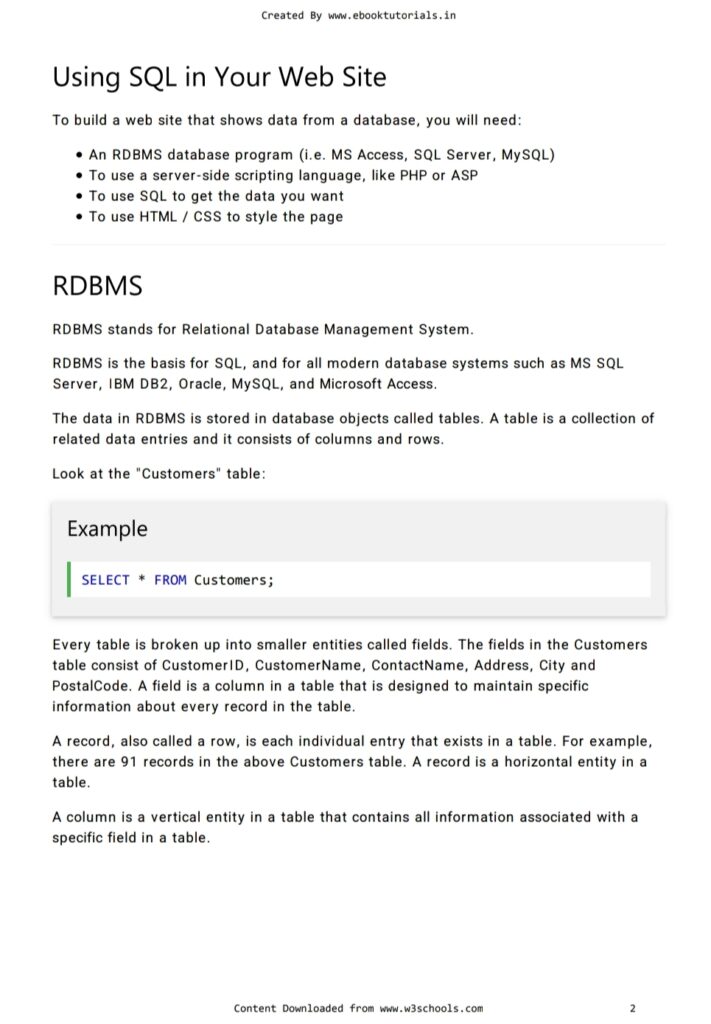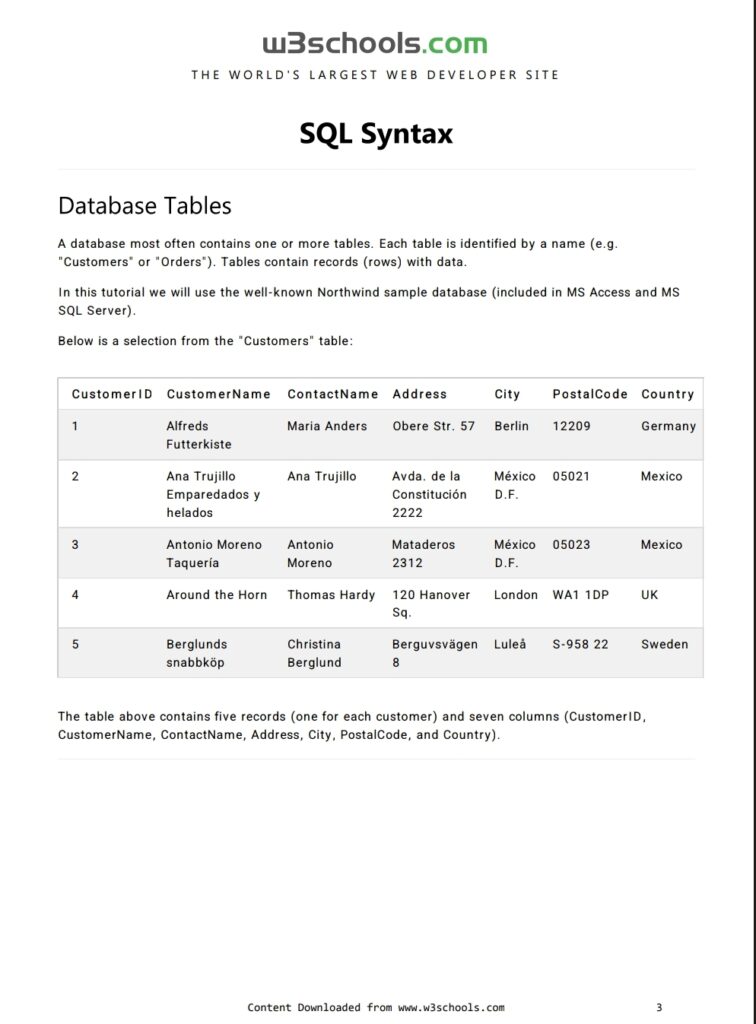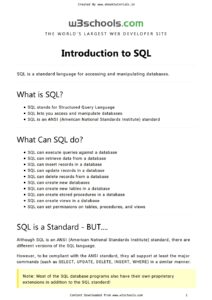Table of Contents:
Introduction:
Master SQL Effortlessly: Powerful Handwritten Notes for Success :


- SQL is one of the important thing in the branch of computer science.
- SQL is one of the fundamental tools in the database management system. It is widely used for handling and manipulating the data.
- It provides secure access control for different users.
- If you build any kind of online application, you must need the Database Management System to store and retrieve the data.
- It plays an pivot role in storing data securely for application like transactions, etc.
Why are handwritten notes helpful for learning SQL ?
It undergoes multiple aspects like
Easy understanding of Syntax
- It makes it easier for users to understand the content easily and efficiently.
- In the tech industry, SQL is very essential as the role is as database administrator.
- It feels better to the user if we compare the computer-generated and the handwritten notes.
- Handwritten notes have a higher chance of getting remembered easily and somehow feel easier to the user.
Contents Included in SQL:
Introduction to SQL
Database concepts
Datatypes
SQL Commands
Constraints
SQL Clauses
Joins and Relationships
Indexes and Optimization
Subqueries and Nested Queries
Views and Stored Procedures
Transaction & ACID Properties
Triggers
Functions & Operators
Normalisation
Cloud Based SQL Services
1. SQL Basics: Understanding the Fundamentals
- SQL stands for Structured Query Language.
- It is used to communicate with and manage relational databases.
- SQL allows you to perform operations like retrieving, updating, and deleting data.
2. SQL Syntax: Structure and Rules
- SQL syntax is not case-sensitive, but it’s a good practice to write keywords in uppercase.
- Every SQL statement ends with a semicolon (
;), especially in complex queries.
3. SELECT Statement: Retrieving Data
- The SELECT statement is used to query data from a database.
- Basic syntax:
SELECT column1, column2 FROM table_name; - Use
*to select all columns:SELECT * FROM table_name;
4. WHERE Clause: Filtering Data
- The WHERE WHEREclause filters records based on specific conditions.
- Syntax:
SELECT column1 FROM table_name WHERE condition; - Example:
SELECT * FROM Employees WHERE age > 30;
5. AND, OR, NOT Operators
- Combine multiple conditions using
AND,OR, andNOT. - Example:
SELECT * FROM Employees WHERE age > 30 AND department = 'Sales';
6. ORDER BY Clause: Sorting Data
ORDER BYSorting query results in ascending (ASC) or descending (DESC) order.- Example:
SELECT * FROM Employees ORDER BY salary DESC;
7. DISTINCT Keyword: Removing Duplicates
- Use
DISTINCTto remove duplicate values from the results. - Example:
SELECT DISTINCT city FROM Employees;
8. Aggregate Functions: Summarizing Data
- Common aggregate functions:
COUNT(),SUM(),AVG(),MAX(),MIN(). - Example:
SELECT COUNT(*) FROM Employees;
9. GROUP BY Clause: Grouping Data
GROUP BYGroup rows that have the same values into summary rows.- Example:
SELECT department, COUNT(*) FROM Employees GROUP BY department;
10. HAVING Clause: Filtering Groups
HAVINGIt isUsed to filter groups formedBY- Example:
SELECT department, AVG(salary) FROM Employees GROUP BY department HAVING AVG(salary) > 50000;
11. JOIN Operations: Combining Tables
INNER JOINReturns records with matching values in both tables.- LEFT JOIN Returns all records from the left table and matching records from the right.
- Example:
SELECT Employees.name, Departments.department_name FROM Employees INNER JOIN Departments ON Employees.department_id = Departments.department_id;
12. INNER JOIN: Retrieving Data from Multiple Tables
- Returns only the matching rows between two tables.
- Example:
SELECT Orders.id, Customers.name FROM Orders INNER JOIN Customers ON Orders.customer_id = Customers.id;
13. LEFT JOIN: Including Non-Matching Records
- Returns all records from the left table and matched records from the right.
- Example:
SELECT Students.name, Courses.name FROM Students LEFT JOIN Courses ON Students.id = Courses.student_id;
14. RIGHT JOIN: Complementing LEFT JOIN
- Returns all records from the right table and matched records from the left.
- Example:
SELECT Employees.name, Projects.project_name FROM Employees RIGHT JOIN Projects ON Employees.id = Projects.employee_id;
15. FULL JOIN: Returning All Records
Combines and.LEFT JOINRIGHT JOINReturns all rows from both tables.- Example:
SELECT A.name, B.address FROM A FULL JOIN B ON A.id = B.id;
16. Self JOIN: Joining a Table with Itself
A self-joinSELF JOINIt iswhen a table is joined with itself.- Example:
SELECT A.name, B.manager_name FROM Employees A, Employees B WHERE A.manager_id = B.id;
17. Subqueries: Querying Inside a Query
- A subquery is a query nested inside another query.
- Example:
SELECT name FROM Employees WHERE department_id = (SELECT id FROM Departments WHERE name = 'HR');
18. INSERT INTO: Adding Data to Tables
- Used to insert new rows into a table.
- Syntax:
INSERT INTO table_name (column1, column2) VALUES (value1, value2);
19. UPDATE: Modifying Data
- Used to modify existing records in a table.
- Syntax:
UPDATE table_name SET column1 = value1 WHERE condition; - Example:
UPDATE Employees SET salary = 50000 WHERE department = 'HR';
20. DELETE: Removing Data
- Used to delete rows from a table.
- Syntax:
DELETE FROM table_name WHERE condition; - Example:
DELETE FROM Employees WHERE id = 5;
21. Constraints: Ensuring Data Integrity
- Constraints like
PRIMARY KEY,FOREIGN KEY,NOT NULL, andUNIQUEensure data validity. - Example:
CREATE TABLE Employees (id INT PRIMARY KEY, name VARCHAR(100) NOT NULL);
22. Primary Key: Unique Identifier for Rows
A unique idenAn identifierPRIMARY KEYIdentifies each row in a table.- Example:
CREATE TABLE Students (student_id INT PRIMARY KEY, name VARCHAR(100));
23. Foreign Key: Relating Tables
- A
FOREIGN KEYcreates a relationship between two tables. tablExample: - ple:
CREATE TABLE Orders (order_id INT, customer_id INT, FOREIGN KEY (customer_id) REFERENCES Customers(customer_id));
24. Not Null Constraint: Preventing Null Values
- Ensures a column cannot have a NULL value.
- Example:
CREATE TABLE Products (product_id INT NOT NULL, name VARCHAR(100) NOT NULL);
25. UNIQUE Constraint: Ensuring Uniqueness
- Ensures that all values in a column are unique.
- Example:
CREATE TABLE Employees (email VARCHAR(100) UNIQUE);
26. ALTER TABLE: Modifying a Table Structure
ALTER TABLEIt isUsed to modify an existing table.- Example:
ALTER TABLE Employees ADD COLUMN salary INT;
27. DROP TABLE: Deleting a Table
- Removes a table and all of its data.
- Example:
DROP TABLE Students;
28. UNION: Combining Results from Multiple Queries
- Combines results from multiple
SELECTstatements. - Example:
SELECT name FROM Employees UNION SELECT name FROM Customers;
29. DISTINCT Keyword: Removing Duplicate Data
- Used to return only distinct (unique) values.
- Example:
SELECT DISTINCT department FROM Employees;
30. LIMIT: Restricting Query Results
- Limits the number of rows returned by a query.
- Example:
SELECT * FROM Employees LIMIT 5;
31. BETWEEN: Filtering Within a Range
- Filters data within a certain range.
- Example:
SELECT * FROM Employees WHERE salary BETWEEN 30000 AND 60000;
32. LIKE: Pattern Matching
- Used to search for a specified pattern.
- Example:
SELECT * FROM Employees WHERE name LIKE 'J%';
33. IN: Matching Multiple Values
- Filters data by matching it against a list of values.
- Example:
SELECT * FROM Employees WHERE department IN ('HR', 'Sales');
34. IS NULL: Finding Null Values
- Filters rows with NULL values.
- Example:
SELECT * FROM Employees WHERE manager_id IS NULL;
35. CASE Statement: Conditional Logic
- Allows for conditional logic within a query.
- Example:
SELECT name, CASE WHEN salary > 50000 THEN 'High' ELSE 'Low' END AS salary_level FROM Employees;
36. Transactions: Ensuring Data Consistency
- A transaction ensures that a series of operations are executed successfully or rolled back.
- Example:
BEGIN TRANSACTION; UPDATE Employees SET salary = 50000; COMMIT;
37. COMMIT and ROLLBACK
COMMITSaves changes;ROLLBACKundoes changes made during a transaction.
38. Views: Virtual Tables
A viewVIEWis a virtual table that stores a query result.- Example:
CREATE VIEW EmployeeDetails AS SELECT name, department FROM Employees WHERE salary > 50000;
39. Indexes: Speeding Up Queries
- An index improves query performance by allowing faster searching and sorting.
- Example:
CREATE INDEX idx_department ON Employees(department);
40. Normalization: Organizing Data Efficiently
- Process of organizing data to reduce redundancy and dependency.
- Levels: 1NF, 2NF, 3NF, etc.
41. Denormalization: Optimizing Query Performance
- Denormalization involves combining tables for faster querying at the expense of data redundancy.
42. Temporary Tables: Storing Data Temporarily
- Temporary tables store data only for the duration of the session.
- Example:
CREATE TEMPORARY TABLE temp_table AS SELECT * FROM Employees;
43. Common Table Expressions (CTEs): Simplifying Queries
- CTEs improve readability and allow for easier reuse of subqueries.
- Example:
WITH DepartmentCTE AS (SELECT department, COUNT(*) FROM Employees GROUP BY department) SELECT * FROM DepartmentCTE;
44. Recursive Queries: Handling Hierarchical Data
- Recursive queries are used to query hierarchical data like organizational charts.
- Example:
WITH RECURSIVE OrgChart AS (SELECT id, manager_id, name FROM Employees WHERE manager_id IS NULL UNION ALL SELECT e.id, e.manager_id, e.name FROM Employees e JOIN OrgChart o ON e.manager_id = o.id) SELECT * FROM OrgChart;
45. EXPLAIN: Query Optimization
EXPLAINProvides information about how SQL statements are executed.- Example:
EXPLAIN SELECT * FROM Employees WHERE salary > 50000;
46. SQL Functions: Built-in Operations
- SQL includes various built-in functions like
NOW(),LENGTH(),CONCAT(), etc.
47. SQL Injection: Security Risks
- SQL injection occurs when malicious code is inserted into SQL queries.
- Prevent it by using parameterized queries or stored procedures.
48. Database Backups: Data Protection
- Regular backups ensure data recovery in case of failure.
49. Roles and Permissions: Controlling Access
- Use roles and permissions to control user access to different parts of a database.
50. Monitoring and Logging: Tracking Changes
- SQL logs can help monitor database activity and troubleshoot issues.








